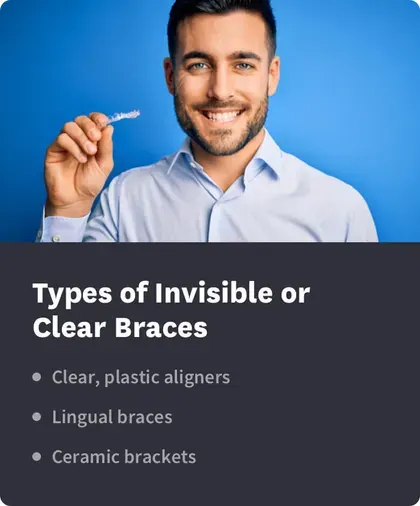Invisible Braces and Aligners: Types & Comparisons

Table of Contents
- What are Invisible Braces & Clear Aligners?
- Types of Invisible Braces & Aligners
- How Do They Work?
- Benefits of Invisible Braces & Clear Aligners
- Costs
- Top Brands
Today, there are many clear and invisible teeth straightening choices on the market, including clear removable aligners, clear (ceramic) braces, and lingual braces.
What are Invisible Braces & Clear Aligners?

Invisible braces and clear aligners are orthodontic treatment options that are designed to be virtually invisible when worn because they are made of a clear or tooth-colored material or because of their placement on the back of teeth.
Types of Invisible Braces & Aligners
There are three main types of invisible braces and aligners.
Like traditional metal braces, ceramic braces are fixed braces. They stay on your teeth throughout treatment until your orthodontist removes them.
Brackets are cemented to your teeth, but the hardware used is either white or tooth-colored in order to blend in with the rest of your mouth. This makes them much less noticeable than metal braces.
Ceramic braces are usually more expensive than metal braces, and they may work slower or be more susceptible to damage or breaking. Staining may also be an issue, as the white or tooth-colored bands may become discolored until they are replaced.
Lingual braces are also fixed and non-removable. They’re usually made of metal. So, how are they virtually invisible? They’re attached to the back of teeth rather than the front.Lingual braces are very expensive, and they may make caring for your teeth more difficult and time-consuming. It may take longer to get used to their back-of-the-teeth placement, which could impact your eating and speaking.
Unlike ceramic or lingual braces, clear aligners are easily removable and can be taken out for meals, dental hygiene routines, and special events. After an initial tooth scan or impression kit, a series of aligners are designed to gradually move your teeth from their current position to an ideal position.
How Do Invisible Braces & Clear Aligners Work?
When many people think of braces, they may think of “traditional” metal braces, which consist of (quite noticeable) metal hardware, including metal brackets and wires. These traditional braces use pressure to move teeth into place.
Brackets are attached to your teeth and connected by bands. An adjustable arch wire runs through these brackets and bands, and it is tightened (through orthodontist adjustments) in order to move teeth as needed. Most patients wear braces for 1 to 3 years.
These same principals are used with ceramic (clear) braces and lingual braces, although for lingual braces, the brackets and other hardware are applied to the back of teeth.
Clear aligners work differently. Clear teeth aligners are custom-designed for your mouth. They fit over your teeth. Each tray has subtle changes and pressure points to guide teeth to where they need to go.
You’ll progress from one aligner tray to the next, through your route to a corrected smile, until your treatment is complete. The average treatment time for clear aligners is 6 months.
Benefits of Invisible Braces & Clear Aligners
For those who don’t want their day-to-day appearance impacted by metal braces, the benefits of invisible braces and aligners are “clear” — they offer a less noticeable alternative for orthodontic treatment.
Clear aligners offer many benefits over even invisible braces, including these:
Flexibility: Unlike braces, clear aligners are removable. While they must be worn as prescribed to work properly, they can easily be taken out, so they don’t interfere with daily tasks like eating, high-impact sports or activity, or brushing or flossing your teeth.
Convenience: Braces require in-office orthodontist visits and adjustments. Many aligner providers offer virtual check-ins throughout orthodontist-supervised treatment. Some, like Byte, offer a completely mail-order experience that begins with an easy and refundable at-home impression kit to see if you’re a candidate for aligner treatment.
Fast treatment: Depending on how complex your orthodontic problem is, braces can take a year or more. Aligners have an average treatment time of around 6 months. Some providers offer helpful tools and may have an even shorter average treatment time.Byte, for example, includes a high-frequency massage tool HyperByte in each of our aligner kits. These types of accessories have been shown in research to help with comfort and results. Byte’s average treatment time is 4 months.
Costs
The cost of invisible braces or aligner treatment will vary by which type of orthodontic treatment you choose.
Ceramic braces cost around $4,000 to $8,000. Many dental insurance plans will cover some or all of the cost of treatment if they are being used to correct an orthodontic problem.
Lingual braces are the most expensive braces option, with a price tag of around $6,000 to $10,000. Because the lingual positioning is usually optional and done for aesthetic purposes, many insurance plans will not cover the extra cost of lingual braces.
When considering the cost of lingual braces, you should also factor in longer (and possibly more frequent) adjustment appointments.
With prices ranging from $900 to $8,000, the cost for clear aligners varies greatly depending on the provider and type of service chosen (in-office or mail-order). While in-office providers and orthodontists may charge more for at-home aligners, the top direct-to-consumer providers offer more affordable prices at around $900 to $2,500.
Many insurance plans may cover some or all of the costs of aligners. Some aligner providers will help you through the insurance process or work with your insurance company directly.
Clear Aligners vs. Clear or Lingual Braces
| Ceramic braces | Lingual braces | Clear aligners | |
|---|---|---|---|
| Visibility | Clear or tooth-colored hardware | Applied to the back of teeth; not visible from front | Clear and fit over teeth |
| How they work | Traditional bracket, band, and arch wire design | Traditional bracket, band, and arch wire design | Gradually move teeth with a series of aligner trays |
| Average treatment time (approximate) | 1–3 years | 1–3 years | 6 months |
| Convenience | Fixed (not removable) – must be applied and adjusted in-office | Fixed (not removable) – must be applied and adjusted in-office; may require additional adjustment time | Can easily be removed; does not require in-office adjustments; some providers offer virtual check-ups or a 100% remote treatment with virtual monitoring and clinical staff access |
| Cost | $4,000–$8,000 | $6,000–$10,000 | At home aligners range from $900-$2,500; in-office aligner prices vary but may cost up to $8,000 |
| Insurance | Many dental insurance plans will cover some or all of the cost of ceramic braces if they are correcting an orthodontic issue | Dental plans may not cover the additional costs for lingual braces | Dental plans may provide coverage for clear aligners if they are addressing an orthodontic issue; some aligner companies will assist you through the insurance process |
| Benefits | Less visible than traditional braces; may be covered by insurance | Virtually invisible; more dentist visits may be appealing to those seeking more care | Clear and removable; fast results; options for 100% remote treatment |
| Disadvantages | Prone to breakage and staining; requires in-office adjustments | Expensive; may take longer to get used to wearing and require more adjustments | Must be worn as advised (usually over 20 hours a day) in order to correct teeth |
Invisible Braces & Clear Aligners: Top Brands
Ceramic and lingual braces are provided and chosen by your orthodontist. Clear aligners allow for more choice.
There are many aligner brands on the market, including these:
Invisalign offers clear aligners through licensed in-office orthodontic providers. Treatment starts with a consultation with a doctor who specializes in Invisalign. You’ll come into the office for check-ins and to pick up aligners.
Invisalign costs vary depending on the provider, but they start at around $3,500. Billing and financing must be worked out with the orthodontist.
Invisalign is a recognizable name in clear aligners, as they helped to popularize clear orthodontics. Today, however, there may be more convenient and affordable options on the market.
Byte is one of the highest-rated clear aligner companies on the market and also one of the most convenient. With an at-home impression kit, a user-friendly website and app, and orthodontic clinical staff available as needed, Byte makes it possible to correct your smile and bite completely from the comfort of your own home. We are also one of the fastest options available, with an average treatment time of 4 months.
Byte’s All-Day Aligner System costs $2,099. This includes all needed aligners for treatment, a high-frequency HyperByte massage tool, premium whitening paste, access to the Byte mobile app, and your first retainer.
Affordable and straightforward payment plans are also available.
Candid used to offer direct-to-consumer clear aligners but now offers their aligners through a hybrid model. You begin treatment with an in-office tooth scan and then remotely check in throughout treatment.
Because Candid no longer deals directly with consumers, pricing will vary depending on the orthodontist providing Candid. Online, some candid providers provide an average cost estimate of around $2,500 for treatment.
SmileDirectClub offers the option of an-office tooth scan or at-home impression kit to start the aligner process. If you decide to move forward, your aligners are then sent to you and check-ins are done virtually throughout treatment.
SmileDirectClub charges $2,050 for its aligner kit. Financing is also available for less than $89 a month with a deposit of $250.
ALIGNERCO offers at-home aligners. After returning your impression kit, you’ll receive a Smile Projection (a 3D proposed treatment plan) in 12 to 14 days. If you opt to continue treatment, your aligners will be sent to you.
ALIGNERCO is one of the most affordable aligner providers on the market. Their aligner kit costs $1,145, and financing is also available.
ALIGNERCO may also offer less in terms of treatment support. Rather than an app or designated clinician, their site claims to provide customers with a “Smile Crew Member” who will act as a liaison between you and a dentist. You may be unable to speak directly to a dentist about your treatment.
